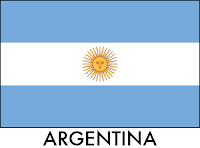
I was recently invited to attend a tasting of the wines of
Bodega Catena Zapata, which has been operating in Argentina since the early 1900s. The third generation winery has achieved stunning success and we had the pleasure of tasting their collectible top line.
Although I am not a collector, these are priced fairly reasonably between $90-130. I say reasonably because they have outscored far more expensive wines in blind tastings and demonstrate great aging potential. The representative pointed out that it would be possible to sell these wines for much more, but that it was the choice of the winemaker to keep them at this level. It should also be noted that most of the reds were being sampled before actual release maturity, meaning that they'll be much better in a few years. The current vintage being sold in Argentina is 2006, while these were from 2008-2010. (There's also the complicating factor that the oceanic voyage adds about a year of aging in a short time due to temperature fluctuations and motion.)
 Fredric Koeppel
Fredric Koeppel,
Michael Hughues, and a lot of wine shop representatives were present for the lunch at
Erling Jensen's, a classy fine dining establishment named after the owner and head chef. I've had Jensen's food before at a few events, but this was my first time dining there. And though we only had two courses, they were delicious. We didn't get told precisely what we were eating, but to the best of my knowledge this is sea bass over toasted brioche with a lobster cream sauce. Silky, rich, yet not too heavy. Just enough to enjoy the flavors of each ingredient. However, it was even better with the following white wines...

The two Chardonnays came as a huge surprise. In a blind tasting these would easily be distinguished for fine white Burgundy, and they've gone from comparing the wines to that general AOC to specifying specific subregions.
2010 Catena White Stones Chardonnay
Mendoza, Adrianna Vineyard
100% Chardonnay
$93, 13% abv.
Touches of honey and light floral elements with a bit of vanilla. Deep and rich with concentrated flavors, bright acidity, and a beautiful golden color.
2010 Catena White Bones Chardonnay
Mendoza, Adrianna Vineyard
100% Chardonnay
$125, 13% abv.
For every 10 barrels of White Stones, only 1 barrel of White Bones is made. Though made nearby, the terroir is different creating a wine with notes of wet stone and earth with just a little touch of lemon in the background. Once again, bright and firm acidity with some playful citrus notes. Going back and forth between the two was a wonderful experience. However, as the plates and glasses were cleared, we prepared our palates for a substantial lineup of red wines.

Beef tenderloin over mashed cauliflower with a sauce espagnole. I believe that the tenderloin was lightly smoked, but it was tender and while the overall dish was uncomplicated, it was well-executed and savory without being overfilling. Just enough to enjoy between sips of the following:
2009 Catena Adrianna Vineyard Malbec
Mendoza, Adrianna Vineyard
100% Malbec
$130, 13.9% abv.
Raspberry and a touch of brambles with a slight bitter note. Strong tannins, very tart with notes of leather and tobacco that emerged a bit as it breathed. All wines were tasted straight from the bottle without decanting, and as I said, a lot of these have a really strong structure now that is going to unwind into a much gentler profile in a few years (as the last wines will indicate.)
2008 Catena Argentino Malbec
Mendoza, Adrianna/Nicasia Vineyards
100% Malbec
$130, 14% abv.
Earth and straw aromas, with plum and black cherry flavors dominating on the tongue. Tart with medium tannins and a firm finish.
2008 Catena Nicasia Vineyard Malbec
Mendoza, Nicasia Vineyard
100% Malbec
$115, 14% abv.
Deep black cherry and licorice, dark and chewy, very concentrated with a long finish. Out of many of the reds, I'd be really interested in seeing how this develops over the next five to ten years.
2008 Nicolás Catena Zapata
Mendoza, four vineyards
65% Cabernet Sauvignon, 35% Malbec
$130, 14% abv.
Really stunning and sublime for a relatively young wine. Much of the complexity of the above wines but softer in every regard, allowing gentle cherry, chocolate, and oak aromas to emerge. Very long finish and quite fascinating.
 1999 Nicolás Catena Zapata
1999 Nicolás Catena Zapata
Mendoza, La Piramide/Adrianna Vineyards
82% Cabernet Sauvignon, 18 % Malbec
$?, 13.8% abv.
This wine is available in limited quantities and represents the second release of the Nicolás Catena Zapata. Perfect aging with dark fruits and gentle spice dominating the profile, yet with no one element overpowering the other. Soft tannins and much of the tartness from the younger wines was gone. It reminded me a lot of Barolo tastings in terms of how rewarding a decade or more can be in terms of the right grapes in the hands of the right winemaker. While I don't know if any other readers will get a chance to try this before the vintage is gone, it does provide a lot of promise for those still-availble wines from 4-5 years ago.
Note: These wines were provided as samples for review.
 2006 La Fiorita Brunello di Montalcino Riserva
2006 La Fiorita Brunello di Montalcino Riserva






















